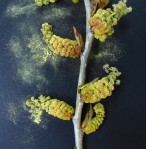
Millions of grains of pollen, in this case from a cottonwood tree, can easily fill the air and travel great distances when picked up by the wind.
Now that the weather has turned warmer and more pleasant, TV news anchors and meteorologists need something other than the weekly snow fall and deep freeze to grab your attention. Enter the pollen count. During the spring months, when trees and grasses release their pollen, official pollen counts get a lot of attention. This isn’t news to you. What you may not know is that in most areas of the country, the publicized pollen counts may be at least partially inaccurate.
In fact, the graphs and numbers reported on television, radio and the internet might actually be yesterday’s news. That’s because, in many cases, the pollen stations report collections from the previous 24-72 hours. You might then ask yourself “why would I read yesterday’s news?” The answer is two-fold. (1) As with weather forecasts, history is used to forecast changes in pollen concentration.(2) Yesterday’s pollen may be at the root of today’s sick visits. That said, you should always remember that a forecast is nothing more than an educated guess. That guess is not only as variable as the weather forecast, but it is highly affected by frequent and unexpected fluctuations in weather.
Pollen.com allows you to type in your zip code and retrieve just such a forecast. Whether or not the forecast is completely accurate, the site does do a nice job of revealing individual pollens that are prevalent in your area. It also provides excellent graphics that reveal pollen sources. Both are valuable features. Reviewing the individual tree pollens is particularly interesting, as the data indicates that while many trees cause allergic symptoms, not all achieve high pollen counts.
For even more specific — and potentially more accurate — data, find out if hospitals in your community have a certified pollen and mold counting station. In my area — New York/New Jersey — we have an excellent one, www.nynjpollen.com, which reports daily on weekdays. Like pollen.com, they provide ranges of pollen units classified as low, medium or high to make it easy for patients to understand the basic pollen outlook for the day.
So what is the best way for you to use the pollen count in your office? It is a good idea to print pollen counts from reliable sources and post them in your office each day where they are easily viewed by both patients and staff. This “in-your-face” technique can often help everyone connect the dots. Once the patients understand the connection between their symptoms and the pollen counts, they are less likely to come to you with the complaint of “sinus infection” in search of an antibiotic, and more likely to come with the expectation of a diagnosis and treatment plan for their allergic disease.
I’m sure you have some of those super-sensitive allergic patients whose nose and eyes seem like radar detectors for increased pollen levels. The moment the levels rise, these patients are at your doorstep with their rhinorrhea, conjunctivitis, sinusitis and tight chests. In my practice, these canary-in-the-coal-mine patients serve as my own reminder to begin collecting information from my local pollen count stations to see if they match up with each patients’ specific allergy test results. If a patient’s tests results indicate allergy to Birch, Oak, Maple and Elm trees, for example, and the pollen count is high for one or more of these trees, then I know targeting her treatment will be relatively easy. However, it is important to figure in the potential combination of that tree allergy with grass allergy, along with the other allergenic elements affecting the patient. The person who has been suffering with tree pollen allergy in April and then gets hit with the double whammy of grass pollen on top of that in May is one you know you will see repeatedly with multiple allergy-related issues…. until you get her or him on immunotherapy.
Pollen is not just pollen — it’s important to identify the real culprit. Targeted allergen immunotherapy, with either shots or drops, can prevent future seasons of suffering. The AllerVision program is designed to help you test for all of the relevant pollens in your area of the country and then to order a treatment set that provides relief and protection.
Again, an accurate pollen report posted daily in clear view can serve as a valuable resource in your practice. For most patients, it’s an education tool. But some patients tend to go into a panic immediately upon report of high pollen counts. I hear them cry, “I’m moving to another state to get away from this pollen.” Unfortunately, as we have all learned, there is almost nowhere left to run. Even Arizona, once a haven for allergy sufferers, has become a massive pollen breeding ground. Sufferers migrating from the southern and eastern states brought their allergenic plants with them and turned wide open spaces into golf courses. Therefore, a more sound recommendation for these patients is to plant only female trees around their home because they do not produce pollen. Of course, allergy sufferers have no control over the neighbors’ yards. The best advice: give serious thought to allergy immunotherapy for a lifetime of protection.
– Dr. Dean Mitchell
